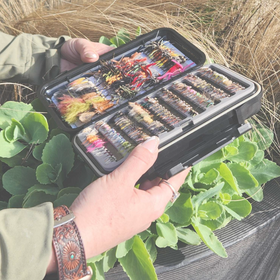Lake fishing with a fly can seem daunting to the newcomer. Even a seasoned river fly fisher can become disillusioned with lake fly fishing, and give it up before really giving it a chance. In this article we will be examining where to find fish in lakes.
First off lake fish and river fish have the same needs. They need to feel secure, and they need to eat. The greatest difficulty in figuring out where lake fish might meet these needs is that from above the lake the water doesn't give us many clues, and sometimes none at all. Rivers are nice enough to change surface appearance, which is probably the single greatest factor in determining likely fishing spots, but lakes do not give us that, or at least not as easily.
Inlets and Outlets
Luckily though one of the best places to find fish is where one can easily see the difference in surface water. And that is the inlet of a lake. Fish often lie in the inlet current, enjoying the cooler well oxygenated water. And also the food that comes with it. For the new lake fly fisher, the current also provides a familiar fishing ally.
Likewise outlets are often good fish holding areas. Outlets generally are full of insects and wary fish. Generally shallower and offering less cover fish in these areas are usually skittish. If one is lucky to be fishing a lake with a deep outlet, that area is likely to offer great fishing time and time again.
Channels
Virtually all lakes have channels at least part way through them. Manmade lakes will have the old river channel through the entire length of the lake. Channels can be hard to locate, often one can spot them only in calm late fall days, when the lake is at its lowest level of the year. Large well fished lakes will often have maps available that will show the channel.
Channels will offer their best fishing late summer, when fish seek cooler water, nymphs will also congregate there, giving fish a ready food source.
Drop offs and Cliffs
Although these two geographic occurrences are somewhat different, their meaning to fish is the same. They provide shade, protection, and easy access to food. Cliffs will trap poor flying terrestrials time and again, sending these errant flyers down into the lake, where schools of fish are apt to be waiting. Windy days aid here in two ways, one providing more difficult flying conditions, and two, giving the water a rippled surface to aid in the angler avoiding detection.
Drop-offs allow fish a sense of security and can be effective mid-day, when fish are hiding out from activity of both humans and predatory birds. If you can locate a drop off close to a food source, you are likely to have a very productive fishing day, and at times insanely productive.
Shorelines, shallows and shoals
One of the most misunderstood facts about lake fishing, is that shallow water more often than not is where the fish are going to be caught. There simply is not food down deep for fish to survive. If one can learn to read shorelines, one can catch big fish in lakes. Here is what to look for;
Irregular shorelines offer the monist protection for fish and aquatic plants. Aquatic plants are important because they offer protection for fish and food for aquatic insects. Also look for shoals, which are just submerged islands, ones that are just off shore offer fish protection and food at the same time, (remember those are the two things fish need). Fish in shallows are very skittish, and will not show themselves in direct sunlight. Dusk is often the best time to pursue these areas.
Reading lakes properly takes practice and patience. If one can, one should learn one lake very well, before attempting another one. Many of the things you learn to read will carry over from lake to lake. And once mastered reading new lakes will become easier, as will the catching of the fish.




